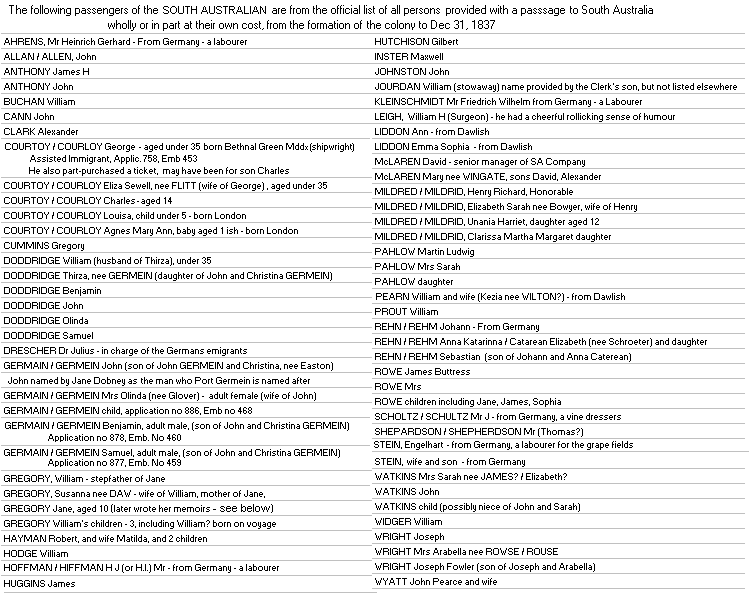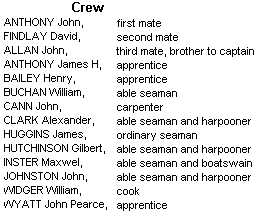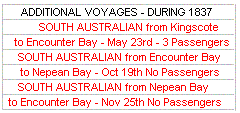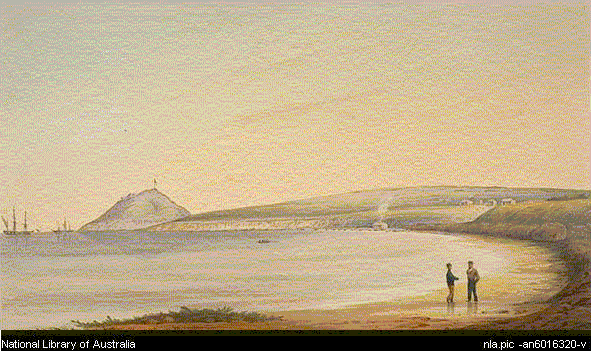The SOUTH AUSTRALIAN 1837-1838The SOUTH AUSTRALIAN was built in 1819 at Falmouth as the MARQUIS of SALISBURY. This 3 masted barque (only 80 feet long) and was designed for mercantile and whaling purposes. She was sold to the Royal Navy and became HMS SWALLOW. In September 1836 she was sold to the South Australian Company and renamed SOUTH AUSTRALIAN. She was then chartered to carry colonists and cargo to the new land to be colonized in South Australia.The SOUTH AUSTRALIAN sailed from London under the command of Captain Alex. Allen, and arrived in South Australia on April 22nd, 1837. 
|

|

|
RECOLLECTIONS OF PIONEER LIFE, shared with us by Kingsley Ireland descendant of Jane Dobney, named as Jane Gregory, who sailed on the SOUTH AUSTRALIAN as a 10 year old child. Original written by Mrs Jane Dobney, January 10, 1902. Published in the Geo News, bi-monthly Newsletter of The Royal Geographical Society of Australasia, (South Australian Branch) Inc. Volume 2, No 5, Nov/Dec 1995. "I was born in North Devonshire on the 16th May, 1827, and should I live till May of next year will be seventy-seven years of age, and, with the exception of failing sight, am in possession of all my faculties. I well remember the stir in my native country when the S..A. Company were seeking emigrants for the new land, and of the active part taken by “Squire” Angas and his agent, Mrs. Lillecrapp, through whose influence largely my stepfather was induced to emigrate. We came out in the “THE SOUTH AUSTRALIAN”, formerly called “THE SWALLOW” which was chartered by the S.A. Company. We sailed from Plymouth on December 24th, 1836. The ship’s longboat was divided into three compartments; a Durham bull was carried in one end and a sick woman in the other; while at one stage of the voyage little Jane Gregory had a baby brother born in the same longboat. We called at the Cape of Good Hope, where we could plainly see fires on land that were lit to keep wild beasts away from Cape Town, in fact, only a week before we called a lion came right into the town. A fellow-passenger with us was John Germein, who subsequently became head pilot, and after whom Port Germein was named. We landed at Kangaroo Island. Our stay extended to eighteen months, during which time the emigrants lived for the most part in tents, and suffered considerable privations. Meat, of course, was a very scarce article of diet, and consisted of beef and pork, so salty that it had to be soaked in water and then parboiled in more water to take some of the salt out, and the water was also very scarce, for we often had to soak and parboil this salt junk in sea water. Our bill of fare was made up of bandicoot, dried mutton bird, and mutton bird’s eggs, with an occasional iguana. Added to this, the flour which was American, and in cakes, was so hard as to require cutting with a tomahawk, and afterwards rolled and sifted before it could be cooked. There was only one store on the island, close to the wharf, the property of the S.A. Company, and at times various articles of household use went up to famine prices. The first cask of salt butter that came to the island was sold at 4/per lb., eggs were 6d. each, soap 2/., and potatoes 6d and 7d per lb. At one time flour was short, and a ration of very hard and dry ship biscuits, that had to be soaked for hours before they were ready for consumption, was served out. Although only a child, I well remember many ships calling at the island during my stay there. On leaving the island, and after landing at the “Old Port”, the journey up to North Adelaide, where I stayed with my mother, had to be made on foot. There was then only one building on the north side of Hindley Street. Bowden was a series of ponds or swamps, where those who were inclined for sport could get as much duck-shooting as they desired. Blacks were very numerous and troublesome. Two were hanged near the old iron stores on the north side of the Torrens for the murder of white men. They were also great thieves, and would take clothes off the line even in the daytime. I have clear recollections of Governor Hindmarsh and Colonel Light, and also of the first Judge who was always called “Mr. Jeff”, and was very eccentric, wearing his trousers so short as to display several inches of sock above his boots. During our stay at North Adelaide the first Government House, a weatherboard affair, was burnt down, and the first exploring party under Sturt was organized and started during the same period. I remember very vividly the procession down King William St. In 1845 I was married to Mr Dobney, a builder by trade, who built the first chapel at Kapunda. I have lived to see many changes, and perhaps may see many more." |
|


